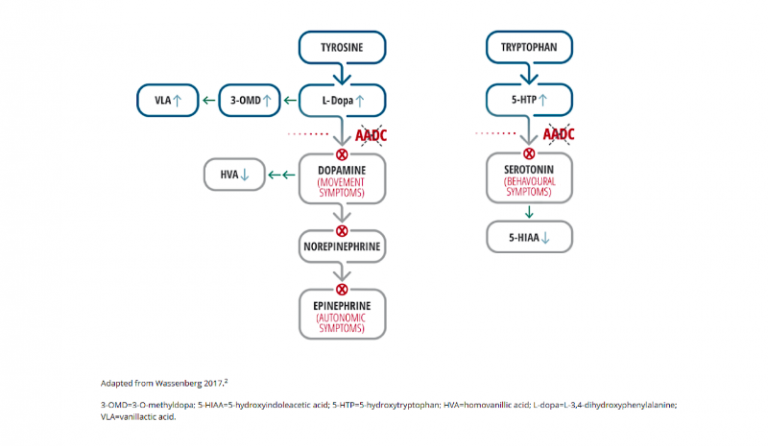What is AADC deficiency?
Aromatic L-amino acid decarboxylase (AADC) deficiency is a rare, inherited neurotransmitter disorder and a lifelong condition. It results in severe motor and autonomic dysfunction, developmental delay and premature death.1–3
AADC deficiency can manifest with a broad spectrum of symptoms, some of the most common being:1–3
- Hypotonia
- Developmental delay
- Movement disorders, especially oculogyric crisis
In the published consensus guidelines:2
- The mean age of onset of symptoms for patients with AADC deficiency is 2.7 months
- Despite this early age of symptom onset, the mean age of diagnosis is 3.5 years
Patients of any gender, ethnic origin or geographic region can be affected by AADC deficiency and, without treatment, symptoms typically do not improve.1–4
What is the biochemical basis of AADC deficiency?
AADC deficiency is an autosomal recessive condition affecting the dopa decarboxylase (DDC) gene, resulting in impaired activity of the AADC enzyme. AADC is involved in the production of several neurotransmitters – notably dopamine, serotonin, adrenaline and noradrenaline – the production of which is decreased in patients with AADC deficiency.2
This is also associated with an increase in metabolite concentrations of levodopa (L-Dopa), 3-O-Methyldopa (3-OMD) and 5-hydroxytryptophan (5-HTP), and a decrease in homovanillic acid (HVA) and 5-hydroxyindoleacetic acid (5-HIAA) concentrations.2
The severe combined imbalance of these metabolites in AADC deficiency causes the somatic and autonomic symptoms associated with the condition.2

Patients with this rare condition can easily be misdiagnosed.
Use the resources on this site to help to ensure that patients with AADC deficiency receive a timely, accurate diagnosis.
Find out about overlapping symptoms
REGISTER HERE for access to exclusive expert-led educational content
- Manegold C, et al. J Inherit Metab Dis. 2009;32(3):371–380.
- Wassenberg T, et al. Orphanet J Rare Dis. 2017;12(1):12.
- Brun L, et al. Neurology. 2010;75(1):64–71.
- Hwu WL, et al. JIMD Rep. 2018;40:1–6.